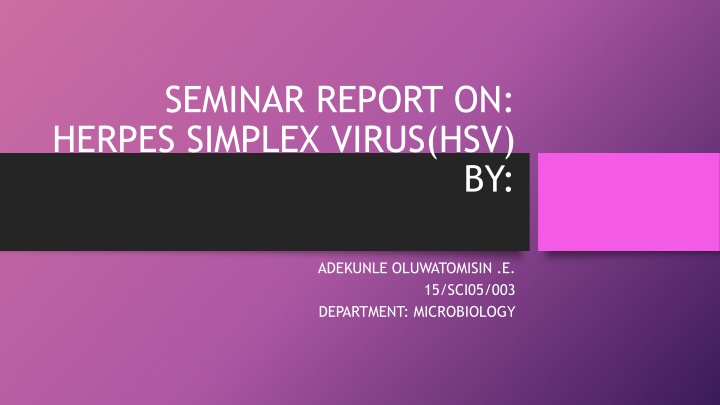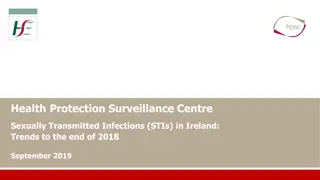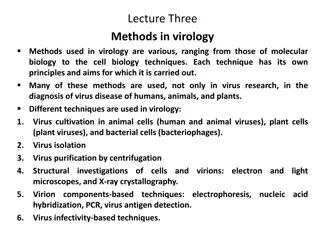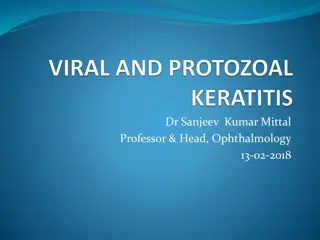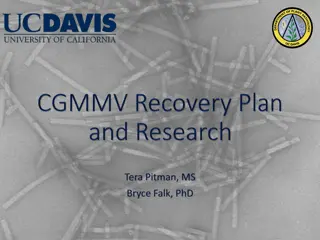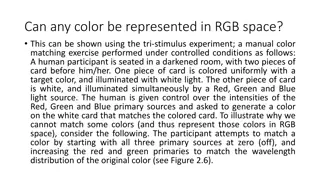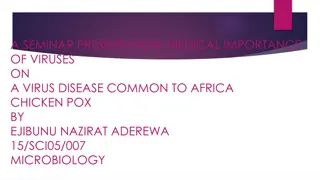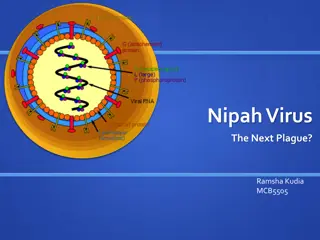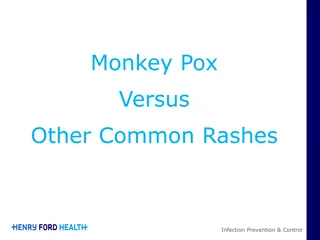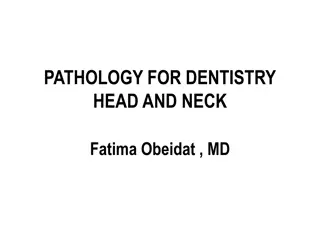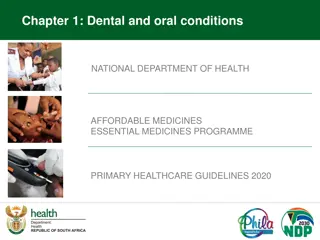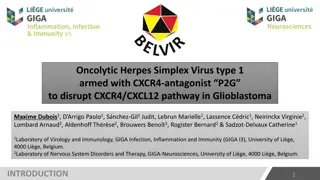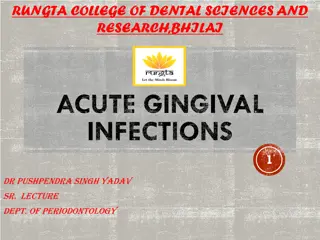Seminar Report on Herpes Simplex Virus (HSV) - Overview and Insights
Herpes Simplex Virus (HSV) is a viral disease caused by HSV-1 and HSV-2, members of the Herpesviridae family. Learn about the classification, transmission, symptoms, and treatment of HSV in this comprehensive seminar report.
Download Presentation

Please find below an Image/Link to download the presentation.
The content on the website is provided AS IS for your information and personal use only. It may not be sold, licensed, or shared on other websites without obtaining consent from the author.If you encounter any issues during the download, it is possible that the publisher has removed the file from their server.
You are allowed to download the files provided on this website for personal or commercial use, subject to the condition that they are used lawfully. All files are the property of their respective owners.
The content on the website is provided AS IS for your information and personal use only. It may not be sold, licensed, or shared on other websites without obtaining consent from the author.
E N D
Presentation Transcript
SEMINAR REPORT ON: HERPES SIMPLEX VIRUS(HSV) BY: ADEKUNLE OLUWATOMISIN .E. 15/SCI05/003 DEPARTMENT: MICROBIOLOGY
TABLE OF CONTENTS INTRODUCTION VIRUS CLASSIFICATION TYPE OF DISEASE ROUTE OF INFECTION PATHOGENICITY OF THE VIRUS COMMON SITES IMAGES STRUCTURES SYMPTOMS TREATMENT AND CONCLUSION CONTROL MEASURES CONCLUSION
INTRODUCTION Herpes Simplex is a viral disease caused by the Herpes Simplex virus. Herpes simplex virus 1 and 2 (HSV-1 and HSV-2), also known as human herpesvirus 1 and 2 (HHV-1 and HHV-2), are two members of the herpesvirus family, Herpesviridae, that infect humans.Both HSV-1 (which produces most cold sores) and HSV-2 (which produces most genital herpes) are ubiquitous and contagious. They can be spread when an infected person is producing and shedding the virus. In simple terms, herpes simplex 1 is most commonly known as a "cold sore", while herpes simplex 2 is the one known by the public as "herpes", or "genital herpes". HSV can also spread to the eyes, causing a condition called herpes keratitis. This can cause symptoms such as eye pain, discharge, and a gritty feeling in the eye.
VIRUS CLASSIFICATION Herpes virus belong to the virus; Group: Group I (dsDNA) Order: Herpesvirales Family: Herpesviridae Subfamily: Alphaherpesvirinae,which is a taxonomic subfamily that can reproduce. Genus: Simplexvirus Species: Herpes simplex virus 1(HSV-1) and Herpes simplex virus 2( HSV- 2).
TYPE OF DISEASE HSV-2 which is also known as a genital herpes is often classified as a Sexually Transmitted Disease(STD). It causes a disease known as Herpes genitalis Likewise the HSV-2, HSV-1 commonly causes sores and blisters around the mouth which may have been contacted through kissing an infected person or sharing utensils like plates, spoons, and cups with an infected person unknowingly. It causes a disease known as Herpetic gingivostomatitis and Herpes labialis
ROUTE OF INFECTION Herpes simplex virus are both neurotropic and neuroinvasive viruses. A neurotropic virus is capable of causing harm to the nerve cells while the neuroinvasive virus is capable of entering the nerve cells which would later lead to an infection When these viruses are able to invade the nervous system, they engage in a constant battle with the antibodies and weaken them inorder to be able to carry out their harmful replication which brings about infection to the nerve cells and the body in general. Both viruses may be transmitted vertically during childbirth. However, the risk of infection transmission is minimal if the mother has no symptoms or exposed blisters during delivery. The risk is considerable when the mother is infected with the virus for the first time during late pregnancy.
PATHOGENICITY OF THE VIRUS Man is the only natural host to HSV, the virus is spread by contact, the usual site for the implantation is skin or mucous membrane. Herpes labialis/cold sores: Caused mainly by HSV-1, there have been reported cases caused by HSV-2. Primary infections with HSV-1 are acquired usually in childhood and may be asymptomatic or subclinical. Symptomatic primary infections present mainly as gingivostomatitis, with fever, sore throat, fetor oris, anorexia, cervical adenopathy, and mucosal edema and vesicular and ulcerative painful lesions involving the buccal mucosa, tongue, gums, and pharynx. Ulcers heal without scarring within 2-3 weeks. Recurrent infections have generally milder symptoms and clinical course. Genital herpes: It is a sexually transmitted disease. Genital herpes is caused mainly by HSV-2, although HSV-1 has become as common as HSV-2 in primary genital infections in developed countries. Primary genital herpes is characterized by formation of multiple, bilateral, painful, and extensive genital ulcers, which heal without scarring within 12 days.
Common sites The HSV-1 primary site is the mouth, tongue, and in rare conditions the eyes. This is the site for the HSV-2 type
STRUCTURE They are 120-300 nm in diameter and consist of a linear, double stranded DNA genome enclosed within an icosahedral capsid,surrounded by a phospholipid rich envelope. The lipid envelope is derived from the nuclear envelope of the infected cell
SYMPTOMS Blisters that break open and form small ulcers, fever, swollen lymph nodes. This are the common symptoms associated with the HSV-1 infection. Most people with HSV-2 do not realize that they are infected. Many people infected with HSV-2 display no physical symptoms individuals with no symptoms are described as asymptomatic or as having subclinical herpes. When symptomatic, the typical manifestation of a primary HSV-1 or HSV-2 genital infection is clusters of inflamed papules and vesicles on the outer surface of the genitals resembling cold sores.
TREATMENT AND PREVENTION Treatment: Antivirals may reduce asymptomatic shedding; asymptomatic genital HSV-2 viral shedding is believed to occur on 20% of days per year in patients not undergoing antiviral treatment, versus 10% of days while on antiviral therapy. Prevention: Going for regular check ups at the clinic to know if one infected so as to carry out proper action if the virus is present. Use of condoms. Blood tests looking for antibodies to HSV-1 and HSV-2 can also help diagnose these infections. This is especially helpful when there are no sores present. Abstinence. Avoid sharing cutleries and always know the status of your partner.
CONTROL MEASURES Infected people should be quarantined inorder to prevent the virus from spreading rapidly.
CONLUSION There is currently no cure for this virus. Treatment focuses on getting rid of sores and limiting outbreaks. It is possible that your sores will disappear without treatment. However, your doctor may determine you need one or more of the following medications: acyclovir famciclovir Valacyclovir People who become infected with HSV will have the virus for the rest of their lives. Even if it does not manifest symptoms, the virus will continue to live in an infected person s nerve cells.
